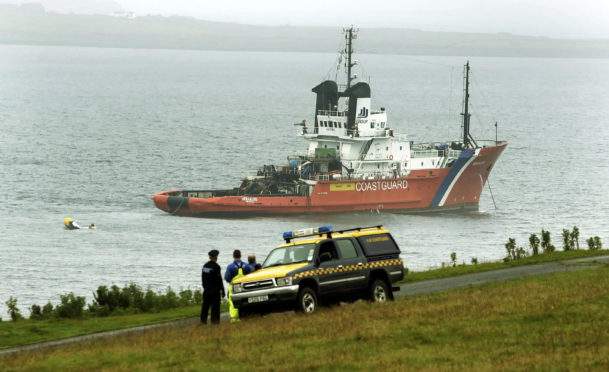Pilots can lose concentration when their aircraft is put into autopilot, according to an expert witness at the Shetland helicopter tragedy fatal accident inquiry.
Steve Jarvis, a doctor of philosophy who works in the aviation industry, said a symptom known as “vigilance decrement” was a common factor where concentration over prolonged periods of time cannot be sustained.
He said monitoring of instruments could worsen unconsciously when the flight is automated.
A report by the Air Accidents Investigation Branch in the 2013 crash, which is playing a major part in the inquiry, has said flight instruments were “not monitored effectively” by the pilots in the moments leading up to the crash.
The AAIB said a lack of monitoring meant a reduction in air speed was not noticed by the pilots and attempts to recover control were too late prior to the crash in foggy conditions just two miles west of Sumburgh Airport.
Dr Jarvis was instructed by CHC Scotia, the operator of the Super Puma involved in the crash, and researched specifically “eye-tracking” of flight controls by pilots.
He said there were situations where pilots, during automation of a helicopter, could unconsciously not monitor instruments during the flight, believing these were under already control.
There were also times when each pilot possibly believed the other was monitoring the instruments, particularly relating to height and speed.
Dr Jarvis said: “All pilots are vulnerable to human issues that disrupt issues relating to monitoring.
“Monitoring is the collection of information of the instruments, it can be quite difficult in difficult circumstances.
“It can be unconscious, like driving a car.”
He said most people assume pilots to be consciously monitoring the instruments “all the time” but that was “totally unrealistic”, particularly during times when the helicopter was in autopilot.
Dr Jarvis claimed the accident itself involved elements that were “unpredictable”.
Sheriff Principal Derek Pyle said: “The primary problem here is the speed was too low. That was a failure by someone. It was not something wrong with the helicopter.
“For the air speed to drop it can only be the person driving the machine who allowed speed to drop below what it should.
“It comes down to a failure to check the speed of the machine.”
- October 20, 2020
- October 20, 2020
- October 19, 2020
- September 14, 2020
- September 11, 2020
- September 10, 2020
Dr Jarvis said: “What I have seen is that incomplete monitoring is the norm, it happens most of the time.”
Sheriff Pyle asked: “What can be done to solve the problem? What you say is the research is infantile. What strikes me is that we don’t have helicopters falling from the sky on a more regular basis because the pilots won’t do monitoring correctly.”
The fatal accident inquiry also heard from an expert witness that said the chances of a similar tragedy are “remote”.
Dr Steve Jarvis sold the fatal accident inquiry: “The aviation industry has spent many years to put in a resilient system and [ensure] safety barriers are put in place. Almost all of the time nothing goes wrong.
“When something does go wrong there are safety barriers, you have two flight crew. They are duplicating each other.
“The chances of something of this kind happening are really remote. We have to be thorough to learn from this.”
Dr Jarvis said cockpit instrument monitoring had been an issue over many years, but added that the Sumburgh accident was a result of a “collection of circumstances” rather than a single point of blame.
He said: “In this [accident] there were too many things that came together. This was a very rare event.
“I don’t think this exact [incident] will happen again. The industry is trying to stop this type of accident happening again.”
The inquiry continues.
The fatal accident inquiry – being held virtually – is hearing evidence into the tragic circumstances of the Super Puma helicopter crash off Shetland on August 23, 2013.
Highlands and Islands Sheriff Principal Derek Pyle, who is conducting the inquiry, opened the session last Monday, and the hearing entered day eight of evidence yesterday.
Video conferencing technology is being used during the hearing due to Covid-19 restrictions in place throughout courts across Scotland.
The passengers who died on the day were: Sarah Darnley, 45, of Elgin; Gary McCrossan, 59, of Inverness; Duncan Munro, 46, of Bishop Auckland; and 57-year-old George Allison, of Winchester.
A fifth victim, Samuel Bell, believed to be aged 27 and from the London area, committed suicide four years later.
The inquiry was told that he had attempted to save the life of another passenger, Mr McCrossan, after he had managed to escape from the submerged helicopter fuselage.
Sheriff Principal Derek Pyle said: “His death was clearly directly caused by the accident.”
The inquiry is hearing evidence from from survivors, counsel for families, the Civil Aviation Authority, helicopter operator CHC, and plane manufacturer AirBus.
The victims were offshore workers travelling onboard a Eurocopter AS332 Super Puma helicopter belonging to CHC Helicopters when it crashed on approach to Sumburgh Airport on August 23, 2013.
The aircraft had two pilots and 16 passengers. It was flying workers off the Borgsten Dolphin oil platform in the North Sea to Aberdeen, but was stopping at Shetland to refuel.
A report in 2016 by the Air Accidents Investigation Branch is playing a major part in the inquiry which said flight instruments were “not monitored effectively” by the pilots in the moments leading up to the crash.
The AAIB said a lack of monitoring meant a reduction in air speed was not noticed by the pilots and attempts to recover control were too late.
The inquiry is expected to last another two weeks.
